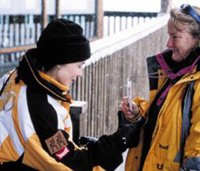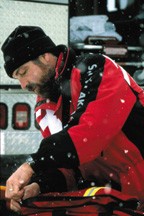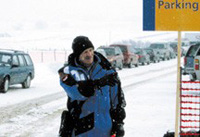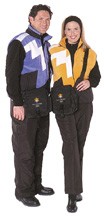|
Numbers mean a lot at the Olympics, and this year’s Salt Lake 2002 Olympic Winter Games will be no exception. A single hundredth of one point in figure skating can mean the difference between medals. Skiers and bobsleds are timed in milliseconds.
But some other numbers that aren’t as apparent are just as important. Three billion people will be seeing the more than 300,000 uniform pieces on 31,000 volunteers in four different color-coded functional areas all designed by one person.
Christina Stenfors-Stark, a designer with the Salt Lake Organizing Committee’s (SLOC) Look of the Games function, has been hard at work since late-1998 working on the volunteer uniform program for the 2002 Olympic and Paralympic Games. She and other members of the SLOC had to pull together suggestions from the Look of the Games and Human Resources committees and Marker Ltd., the official clothier sponsor of the Games, to generate the apparel that volunteer and paid staff alike will wear.
The entire uniform program would require more than personal design and style; it would also incorporate function, durability, Olympic and Paralympic logos, weather conditions and the comfort of those who would be wearing the clothes for the entire duration of the Olympics.
“Overall, there were about a dozen people contributing to the design,” says Darren Hughes, director of Human Resources, Planning and Operations, who was a part of the design team even before Marker Ltd. signed on as a sponsor.
Aside from the variety of input and the list of factors to consider in the design, Stenfors-Stark had the added pressure of impressing not only the volunteers and others on the SLOC, but billions of viewers and attendees as well as the International Olympic Committee (IOC).
“The hardest part of it all was making something that senior management would be pleased with and would support wearing themselves,” she says. “The worst moment was the presentation of it to the IOC to make sure they would like one of the two designs, otherwise it would have been back to the drawing board.”
And to say the IOC liked what they saw in the final design is an understatement. Stenfors-Stark says they gave it a standing ovation.
But while Stenfors-Stark’s fear is gone, Hughes still has some concerns of his own. He has taken charge of the uniforming since the final approval and design work was completed, and what worries him won’t be squelched until Feb. 8, the opening day of the Games.
“With the production deadlines that we have, the changing numbers of people is the part that keeps me up at night,” Hughes says. “I worry about not having enough uniforms to fit people.”
To produce the eight-piece uniforms, Marker set the initial deadline as January 2001. Since then, the headcount was up another 4,000 by August and has continued to rise as the date nears. Though the original order included a 15 percent buffer and Marker has allowed for a reorder in August to include the additional people, that excess buffer is down to about 10 percent as the numbers stand now, according to Hughes.
His fear is compounded by the fact that each of those 31,000 people needs the right uniform — that includes size, color and pieces.
To accommodate everyone, pieces runs from XXXSmall to 8XLarge, with an additional tall size for the pants. Because the volunteer list had yet to be finalized as of December 2001 and the order deadline was 11 months earlier, there was no definite way to order the right number of each size. To better anticipate the sizing factor, the SLOC first asked for size preferences on the preliminary volunteer application.
“We got the actual numbers from the Sydney Games and from the Atlanta Games,” Hughes says, “so we built a distribution curve with their sizes averaged in with what we predict we need based on the preliminary responses.”
They also pulled in a focus group of about 500 people to see how well people aligned their
estimated size with the actual size they would wear from Marker. “And then we basically guessed from there,” he says. “This isn’t an exact science.”
The second factor, color, has even more importance. Hughes explains the four different color schemes for each of four operational areas as well as why their particular color is so important.
Forest (green) — field-of-play: includes course workers, gate judges, technical officials. The green gives a “low profile” and helps distinguish people from gates or bumpers that will be in the blue and red colors. “When you’re going 90 miles perhour, they could be mistaken for a gate for the skiers going that fast.”
Wildfire (red) — medical staff, emergency, ski patrol. People have a tendency to associate red with “emergency,” which could help non-English-speaking attendees.
Amber (yellow) — event services: ticket takers, ushers, bag searchers, security. The yellow will catch people’s eye when they are looking for information or help.
Mountain shadow (blue/purple) –support personnel: transportation, human resources, ticketing. This color is subtler for those who perform the back-of-house duties.
The colors of the uniforms were taken from the 2002 Olympic crystal logo, which was created to incorporate the Olympic torch with the mountainous terrain and the Western culture of Salt Lake. While only two pieces, the parka and vest, of the eight-piece uniforms have the specified color scheme, those pieces are the central focus of the entire program.
“The vest and parka both have the cropped crystal,” says Stenfors-Stark. “It’s the outer layer that is really the distinctive feature of the uniform. They needed to be distinctive from any other skiwear that would be worn at the Olympic Games, like spectators’ and athletes’ jackets.”
Hughes and Stenfors-Stark both emphasize the need for the parka/vest choice due to the variety in temperature, both between indoor and outdoor events and in the varying temperature of Salt Lake City in February and March.
Hughes says, “The weather can be quite volatile. You might have a day that’s 20 and the next might be closer to 50.”
The parka is waterproof and fully lined with custom Olympic ring buttons, ‘pit zips’ for underarm ventilation and the rings embroidered on the back. The vest follows the same pattern but is made of fleece with a nylon overlay. Other methods were tried with less success fleece-to-fleece (colors bled), embroidery on fleece (weakened material), silk-screening fleece (unattractive).
The other six pieces are a micro-fleece half-zip black turtleneck, black shell ski pant, fleece headband, fleece cuffed hat, leather gloves with polypropylene glove liners and cross-pack. Again the variety in temperature prompted them to choose a waterproof and windproof shell pant vs. an insulated one so those outdoors can layer easily and those indoors won’t overheat. The headband and hat are black with tone-on-tone logos, “so they didn’t look like they had a big target on their heads,” says Hughes. The cross-pack was inspired by the Pony Express to incorporate the Western theme, yet be durable and functional to hold personal belongings and credentials.
Stenfors-Stark says, “The fabrics had to look good. They have a slight sheen to them to give that technical look without being too garish or bright.”
Considering sizes, colors and pieces, there are over 400 SKUs and more than 300,000 pieces that need to find their way to the right worker. That will all happen in the Team 2002 Processing Center, a 52,000 square foot building that will function as both a warehouse and uniform distribution center. Volunteers and staff will choose from three 3-hour sessions either Dec. 17 through Feb. 15 for the Olympic Games or Feb. 25 through March 9 for the Paralympic Games. They will receive their credentials, take a spin through the fitting room, and then proceed to each station, gathering their uniform pieces cafeteria-style.
“Our plan is to process roughly 100 people per hour,” Hughes says. If you do the math, that would be two weeks if they were open around the clock. Instead, it will be about 35 10-hour days.
Sheer size, speed and use alone make this uniform program unique. Add in the custom design, custom dyed fabrics and how many people will see it and it really is a project of Olympic proportions.
|















